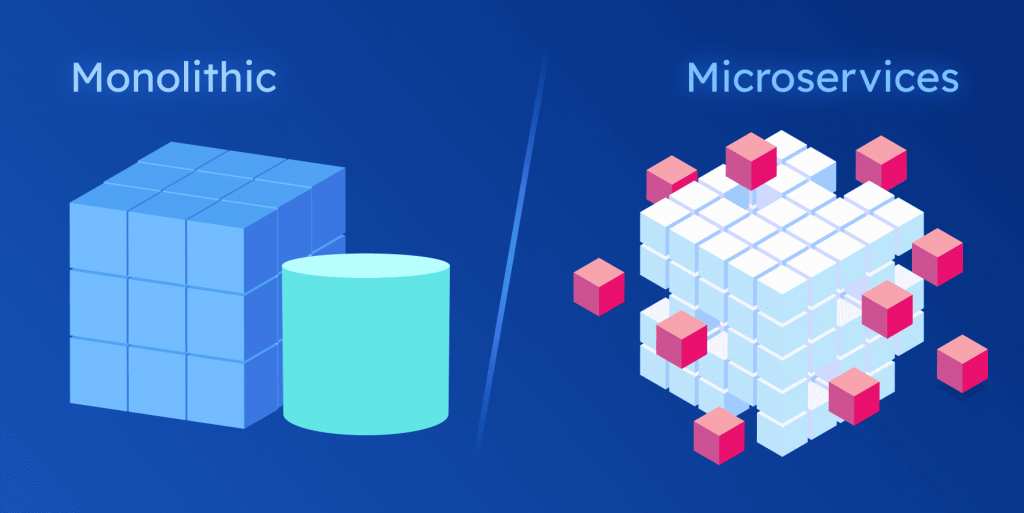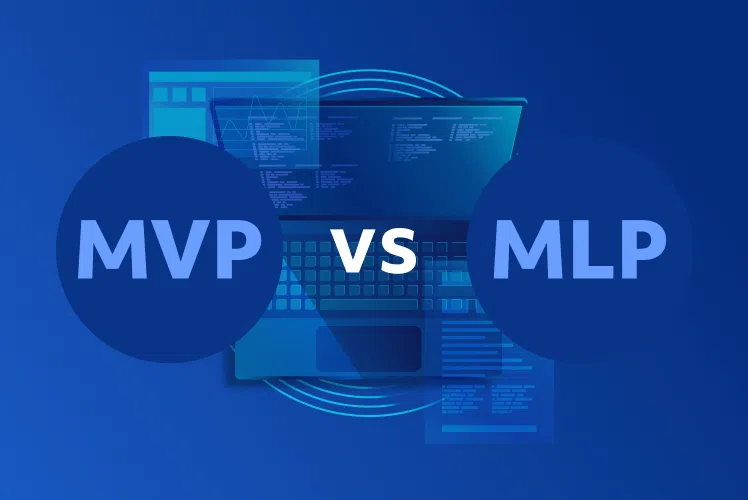Table of Contents
When building software, architecture isn’t just a behind-the-scenes decision; it’s a core strategic choice that shapes everything from team structure to time-to-market. Two architectural styles dominate the conversation: monolithic and microservices. Each has its benefits, drawbacks, and best use cases.
In this article, we compare monolithic vs microservices to provide a better understanding of each approach and to help you decide what will be a better architecture choice for your next project.

What is monolithic architecture?
Monolithic architecture is a traditional approach to software design where an application is built as a single, unified unit. That means that all its components are interconnected and operate within one codebase. Therefore, when you deploy the app, you’re deploying the whole thing at once.
This architecture is often likened to a “big box,” where all functionalities are bundled together. So, any changes or updates, even the small modifications, require rebuilding the entire system to implement them.
Although many companies today prefer to move away from monolithic architecture in favor of microservices due to certain limitations, monoliths still offer several advantages that make them a valid choice for specific use cases. The key benefits of monolithic architecture include:
- A monolithic application is typically easier to develop, especially at the beginning, because all components are part of a single codebase.
- Deployment is straightforward since there’s only one deployable unit, reducing coordination and complexity.
- Testing a monolithic application is generally simpler due to the absence of inter-service communication and the use of a single runtime environment.
- Initial development and hosting are usually less expensive, making it suitable for startups or MVPs.
- No need for container orchestration, inter-service communication management, or network resilience strategies.
However, the limitations are still there. Some of the drawbacks of monolithic architecture include:
- You scale the entire application, even if only one part needs more resources.
- As the codebase grows, it becomes more complex and harder to manage.
- Minor changes can require full redeployment.
- Since the entire application is deployed as a single unit, a small change in one part can potentially affect the entire system.
- The need for complete integration and end-to-end testing before each deployment hinders frequent releases and automation.
What is microservices architecture?
Now that we answered the “what is monolith” question, let’s continue with microservices. The microservice architecture breaks an application into a collection of smaller, loosely coupled services. Each service focuses on a specific business function and, unlike monolith, can be developed, deployed, and scaled independently. These services communicate with each other through well-defined APIs.
The main advantages that draw businesses toward the microservices approach include:
- As we mentioned, microservices can be developed, tested, deployed, and updated independently without affecting the entire application.
- Services can be scaled individually based on demand.
- Failures in one microservice typically don’t crash the whole system.
- Services can be scaled individually based on demand.
- Different services can be written in different programming languages or use different databases, depending on what suits each best.
- Microservices are well-suited for automation pipelines, continuous integration, and continuous delivery.
- Multiple teams can work on different services simultaneously, speeding up development and feature delivery.
However, there are also some drawbacks of the microservices as well.
- Microservices break down applications into many smaller services, which adds architectural complexity.
- Managing inter-service communication, data consistency, and service dependencies requires careful planning and tooling.
- Although services can be deployed independently, changes that span multiple services must be carefully coordinated.
- Requires investment in DevOps tools, container orchestration, and API management.
- Teams need expertise in distributed systems, containerization, orchestration tools, and advanced monitoring.
Microservices vs monolithic: key differences
Understanding the key differences between microservices and monolithic architectures is essential for making informed decisions in software development. We’ve already briefly discussed these approaches, so it’s time to compare microservices vs monolithic in more detail.
Development
Development in monolithic systems is straightforward. Since all components reside in a single codebase, developers can quickly understand the flow, debug, and implement features. However, the larger the system grows, the more cumbersome it becomes to make even minor changes.
Development in microservices is distributed. Teams can work on different services independently without stepping on each other’s toes. This independence allows for faster feature delivery but requires a strong foundation in version control, API contracts, and inter-team communication.
Deployment
As we mentioned, the monolith is packaged and deployed as a single unit. This makes deployment simpler at first but risky — small changes to one part require redeploying the entire application, potentially introducing downtime or unforeseen issues elsewhere.
On the other hand, each service in a microservices architecture is a deployable unit. This makes deployments more agile and localized. Rolling out changes or hotfixes can be done quickly, with minimal impact on the rest of the system. However, managing the deployment of multiple services requires orchestration tools and CI/CD pipelines.
Scalability
Microservices are designed to handle scalability more effectively than monolithic architectures. In a microservices architecture, an application is divided into smaller, independent services that can be deployed, updated, and scaled individually. This means that if one component of the application experiences increased demand, it can be scaled independently without affecting the rest of the system. For instance, an ecommerce platform can scale its payment processing service separately from its inventory management service, optimizing resource allocation based on specific needs.
Monolithic architecture typically requires scaling the entire application as a single unit. This can lead to inefficiencies, as developers may need to allocate resources based on the most demanding components, even if the rest of the application does not require additional capacity. As a result, scaling a monolithic application can be more complicated and less efficient, particularly for large-scale systems.
Growth
When considering growth, microservices provide a more flexible framework for evolving applications. The modular nature of microservices allows teams to adopt new technologies and frameworks without overhauling the entire system.
In contrast, growth in a monolithic architecture can be more challenging due to its tightly coupled components. Adding new features or making changes often requires significant modifications to the entire codebase, which can lead to increased development time and the risk of introducing bugs. Additionally, as the system grows, it may become more challenging to manage and maintain, potentially leading to technical debt.
Technology stack
The technology stack used in each architecture also presents a significant difference. In a microservices architecture, teams have the flexibility to choose different technology stacks for each service. This means they can leverage the best tools and frameworks suited for specific tasks, optimizing performance and efficiency. For example, a team might choose a lightweight programming language for a data processing service while using a more robust language for a user interface service.
On the other hand, monolithic architectures typically rely on a single technology stack throughout the entire application. While this can simplify development and reduce the learning curve for teams, it may also limit flexibility. Teams are often constrained to a specific set of languages and tools, making it harder to adapt to new technological advancements or to integrate with modern tools.
Complexities and maintenance
As we mentioned, when monolithic applications grow, they often become increasingly complex. A larger codebase can lead to challenges in understanding, modifying, and debugging the application. The tightly coupled nature of monolithic systems makes it difficult to isolate issues or update individual components without affecting the entire application. Maintenance becomes a daunting task, particularly when changes necessitate extensive testing across the entire system.
While microservices offer modularity that can simplify certain aspects of development, they introduce their own complexities. The distributed nature of microservices can lead to challenges in managing inter-service communication, data consistency, and deployment orchestration. Teams must handle the added overhead of managing multiple services, which can complicate debugging and monitoring.
Here is a comprehensive comparison table of microservices vs monolithic architecture that clearly highlights their key differences.
| Feature | Monolithic architecture | Microservice architecture |
|---|---|---|
| Architecture | Single, unified application. | Distributed system made up of independent services. |
| Deployment | Deploy all at once. | Deploy independently. |
| Development | Centralized codebase, usually one team. | Multiple teams can develop services in parallel. |
| Scalability | Scale entire app. | Scale individually. |
| Security | Easier to manage security, as everything is in one place. | More exposed to security risks due to resilience on API. |
| Technology flexibility | Single technology stack, uniform choices. | Each service can use a different language or technology. |
| Communication | Internal method or function calls within one app. | Communication over APIs or messaging protocols. |
| Data management | Centralized. | Decentralized and service-specific. |
| Maintenance | Harder to update specific parts as the app grows. | Easier to maintain and update individual services. |
| Testing | Easier unit and integration testing. | Complex testing; requires end-to-end, contract, and service-level tests. |
Monolithic vs microservices: which one to choose?
The choice between microservices and monolithic architectures hinges on various factors. Microservices offer a modular, scalable approach that aligns well with modern development practices, making it an attractive option for many organizations. However, monolithic architectures may still be suitable for smaller applications.
Expert Opinion
Regarding this topic, I can add one more vital approach: hybrid architecture – it combines the stability of a core monolith for established functionalities with independently scalable microservices for rapidly evolving or highly demanding areas. This approach is particularly effective during gradual migrations or when specific application parts require distinct scalability, but it necessitates careful management of both architectural styles.
Overall, It’s not about which is better — it’s about what’s right for your current stage, goals, and team. The decision between monolithic vs microservices architecture should be based on:
- Project size and complexity. For smaller projects or MVPs (Minimum Viable Products), a monolithic approach can be more practical. It simplifies development and reduces initial costs. On the other side, for larger, enterprise-level applications, microservices may offer the scalability and flexibility needed to handle complex requirements.
- Team expertise. The existing skill set of the development team is crucial. A team experienced in microservices can leverage its benefits effectively, while a less experienced team may find a monolithic architecture easier to manage.
- Long-term growth plans. Organizations should consider their future needs. If you anticipate rapid scaling and frequent updates, microservices may be the better choice. However, if the project scope is well-defined and unlikely to change significantly, a monolithic architecture may suffice.
Expert Opinion
If you are experiencing any of the issues on that list, it is the right time to consider migrating to a microservices architecture (or at least a hybrid approach).
- You see scalability challenges;
- You need to increase the development velocity;
- You want to have easier maintenance and updates;
- You have an overcoming of technical debt.
These points are the primary drivers and “pain points” that often lead organizations to move away from a monolithic architecture and towards microservices.
Anyway, there’s no one-size-fits-all answer. Choosing between monolithic and microservices architectures is a strategic decision that depends heavily on your organization’s specific context.
To sum it up
Every system is different, so consider your options and business needs to choose the architectural decision that best suits your goals. Start small, build smart, and scale responsibly. If you’re starting out, a well-structured monolith is often your best bet. If you’re scaling up or hitting structural roadblocks, microservices can offer the agility you need — but only if you’re ready for the complexity they bring.


Comments